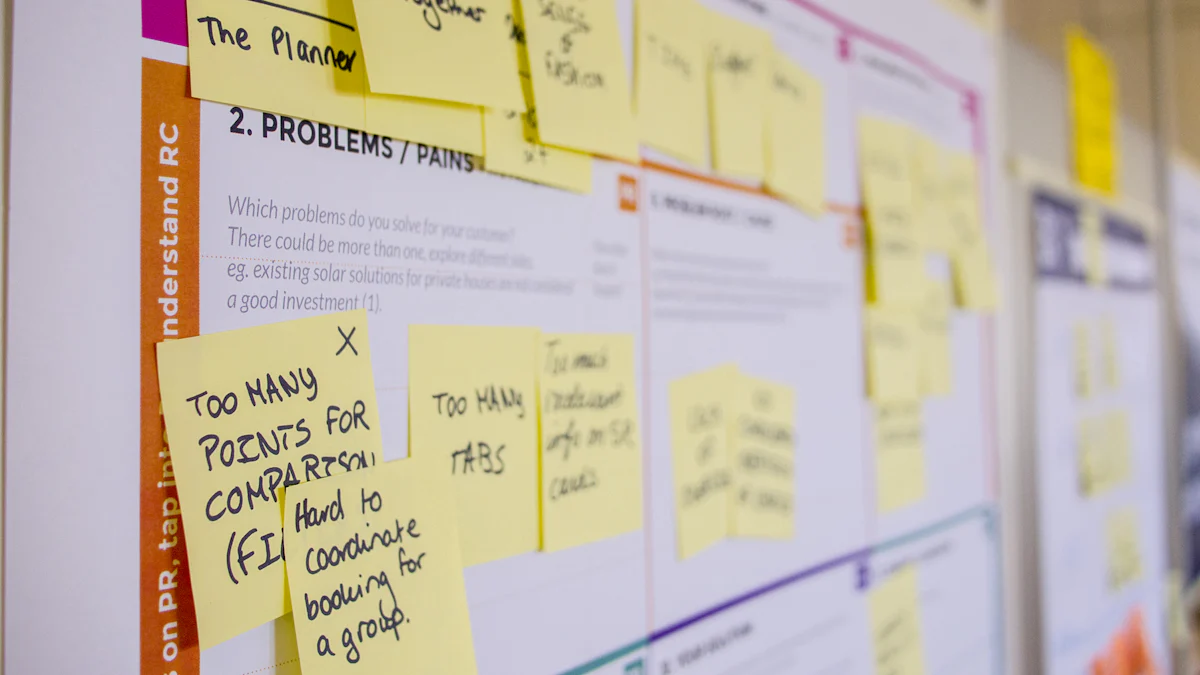How Lean Software Development Benefits Modern Teams

Lean software development empowers you to deliver value faster and adapt to changes with ease. It eliminates waste and inefficiencies, helping your team focus on what truly matters—enhancing customer satisfaction. By adopting lean practices, you can achieve remarkable results. A 2023 study revealed that lean projects are completed 30% faster than traditional ones, while products developed using these methods report a 20% higher user satisfaction rate.
This approach emphasizes rapid delivery and continuous improvement. You can release smaller increments, gather feedback quickly, and refine your product based on real-world usage. Teams using lean in software engineering also report better adaptability, with 85% experiencing improved flexibility. Lean software development ensures you stay competitive while meeting customer needs efficiently.
Metric | Statistic |
|---|---|
User Satisfaction Rate | 20% higher with lean methodologies |
Flexibility Improvement | 85% of teams report better adaptability |
Cost Reduction | 15-25% average savings in projects |
Key Takeaways
Lean software development helps teams work faster by removing waste and focusing on what customers want.
Using lean methods can make projects 30% quicker and improve user happiness by 20%.
Continuous improvement, called Kaizen, means making small changes that bring big results over time.
Tools like Kanban boards and feature flags help teams work together and test new features safely.
Letting teams make decisions builds responsibility, leading to better ideas and accountability.
Why Lean in Software Engineering Matters
Challenges Faced by Modern Software Teams
Rapidly changing customer demands
Modern software teams often face the daunting task of keeping up with ever-evolving customer expectations. The rapid pace of technological advancements and shifting market trends demand constant adaptation. A recent study highlights that 53.8% of teams struggle with adapting to changing client requirements. Balancing these demands with ongoing development can feel overwhelming, especially when 45% of teams also face challenges in keeping up with the rapid release of new tools and platforms.
Challenge | Percentage (%) |
|---|---|
Adapting to changing client requirements | 53.8% |
Balancing feature development with bug fixing | 62% |
Keeping up with rapid release of new tools | 45% |
Pressure to deliver faster without compromising quality
The pressure to deliver high-quality software quickly is another significant challenge. Customers expect seamless experiences, and delays can lead to dissatisfaction. However, rushing development often results in defects or incomplete features. This creates a cycle of rework that drains resources and delays progress. Teams must find ways to balance speed with quality to meet these expectations effectively.
How Lean Software Development Addresses These Challenges
Focus on delivering value to customers
Lean software development ensures your team prioritizes customer value above all else. By focusing on what truly matters, you can deliver meaningful, customer-centric products. This approach eliminates distractions and allows you to align your efforts with customer needs. Lean in software engineering emphasizes iterative development, enabling you to gather feedback early and refine your product continuously.
Reduction of waste and inefficiencies
Eliminating waste is a cornerstone of lean software development. This includes avoiding unnecessary features, excessive documentation, and defects. By concentrating on value-adding activities, you can streamline your processes. Automated testing and continuous integration help build quality into every stage of development, reducing the need for extensive debugging later. Limiting work in progress also minimizes inventory costs, ensuring your team focuses on delivering only what is needed.
Lean development eliminates unnecessary features and partially done work.
Automated testing and continuous integration reduce inefficiencies.
Value Stream Mapping and Kanban boards streamline workflows.
Enhanced team collaboration and adaptability
Lean practices foster collaboration and adaptability within your team. Cross-functional teams work closely, ensuring effective communication and teamwork. Iterative cycles allow you to incorporate feedback early, making it easier to adapt to new customer needs. Lean systems are flexible, enabling your team to adjust to unexpected circumstances gracefully. This adaptability ensures you stay aligned with market demands while maintaining a focus on customer value.
Lean promotes collaboration among team members and stakeholders.
Iterative cycles enhance flexibility and responsiveness.
Cross-functional teams improve communication and teamwork.
Core Principles of Lean Software Development

Value Stream Mapping
Identifying and optimizing the flow of value
Value stream mapping is a powerful tool that helps you visualize and improve the flow of value in your software development process. By identifying each step involved in delivering a product or service, you can pinpoint inefficiencies and focus on what truly matters. Here’s how you can optimize the flow of value:
Identify the product or service you want to map.
Map the current state to understand how materials and information flow.
Highlight steps that don’t add value and categorize them as waste.
Create a future state map that shows an ideal flow of value.
Develop an action plan to transition from the current state to the future state.
Continuously review and refine the process to ensure ongoing improvement.
Value stream mapping enhances team communication and collaboration. It eliminates non-value-adding activities, reduces waste, and boosts productivity in software development.
Eliminating non-value-adding activities
Non-value-adding activities, such as redundant processes or excessive documentation, slow you down. By using value stream mapping, you can identify and remove these inefficiencies. This approach ensures your team focuses on delivering features that matter most to your customers. Streamlining workflows not only saves time but also fosters a culture of efficiency and purpose.
Continuous Improvement (Kaizen)
Regularly refining processes and workflows
Continuous improvement, or Kaizen, is the heart of lean software development. It encourages you to make small, incremental changes that lead to significant results over time. Regularly refining your processes ensures your team stays agile and responsive. For example, holding daily stand-ups or retrospectives allows you to identify bottlenecks and implement solutions quickly.
Encouraging team feedback and experimentation
Empowering your team to share feedback and experiment with new ideas drives innovation. Teams that can prototype and test ideas quickly deliver valuable features more frequently. High-performing teams thrive when they can make decisions independently and iterate based on user feedback. This approach not only improves outcomes but also builds a sense of ownership and accountability within your team.
Just-in-Time Production
Delivering features or work exactly when needed
Just-in-time production ensures you deliver features at the right moment, avoiding unnecessary delays or overproduction. By aligning your work with customer needs, you can prioritize tasks effectively. This method keeps your team focused and prevents wasted effort on features that aren’t immediately required.
Reducing bottlenecks and overproduction
Implementing just-in-time production minimizes bottlenecks and reduces overproduction. Faster stock turnover and smaller investments in resources keep your workflow efficient. For example:
Benefit | Explanation |
|---|---|
Reduced Space Needed | Faster stock turnaround reduces the need for large storage spaces, minimizing bottlenecks. |
Waste Elimination/Reduction | Quicker stock turnover prevents damage and obsolescence, directly addressing overproduction. |
Smaller Investments | Ordering materials as needed maintains cash flow and reduces excess inventory. |
By adopting this principle, you can streamline your processes and focus on delivering value to your customers.
Build Quality In
Ensuring quality at every stage of development
Building quality into every stage of development transforms your software into a reliable and efficient product. When you prioritize quality from the start, you prevent costly mistakes and ensure smoother workflows. This approach involves embedding quality assurance into every step of the process, from planning to deployment. Testers play a crucial role here. By involving them early in the design phase, you can identify potential issues before they escalate. This proactive strategy reduces the complexity and cost of fixing bugs later.
Quality control should never be an afterthought. It must remain an ongoing process throughout the software lifecycle. By continuously monitoring and refining your workflows, you can maintain high standards and deliver exceptional results. This commitment to quality aligns perfectly with the principles of continuous improvement, helping your team achieve better outcomes with each iteration.
Tip: Think of quality as a foundation, not a finishing touch. When you build it into every stage, you create a product that stands the test of time.
Preventing defects rather than fixing them later
Fixing defects after development can drain your resources. A study from the Journal of Information Technology Management revealed that the cost of correcting a bug increases tenfold with each stage of development. For example, a $100 error in the business requirements stage could balloon to $100,000 during implementation. By addressing issues early, you save time, money, and effort.
To prevent defects, focus on early detection and proactive measures. Start with clear requirements and involve testers from the beginning. Make quality assurance an integral part of your process. This ensures that potential problems are caught before they grow. Regular testing and feedback loops also help you refine your product continuously. By adopting this mindset, you can avoid rework and deliver a polished product faster.
Note: Prevention is always better than cure. When you stop defects before they occur, you free your team to focus on innovation and continuous improvement.
Tools and Techniques for Lean Software Development

Kanban Boards
Visualizing workflows to identify bottlenecks
Kanban boards are a game-changer for visualizing your team's workflows. They help you map out every step of your process, making it easier to spot bottlenecks. For example, if tasks start piling up in one column, it signals a delay in that stage. By visualizing blockers, you can quickly identify what’s preventing progress and take action. Adding automation to your Kanban board further optimizes workflow management, ensuring smoother operations.
Map workflows in detail to uncover problem areas.
Highlight blockers to see what’s slowing down task completion.
Use automation to streamline repetitive tasks.
Managing work-in-progress limits for efficiency
Work-in-progress (WIP) limits are essential for maintaining focus and efficiency. They prevent your team from juggling too many tasks at once, which often leads to delays. By concentrating on fewer tasks, you can complete them faster and with higher quality. WIP limits also help you identify bottlenecks in real time, allowing for quick resolutions.
Focus on completing tasks before starting new ones.
Avoid task overload to maintain a balanced workflow.
Resolve bottlenecks faster by limiting WIP.
The 5S Methodology
Organizing and standardizing workspaces
The 5S methodology transforms your workspace into a hub of clarity and efficiency. It consists of five steps:
Sort: Remove unnecessary items to eliminate distractions.
Set in Order: Arrange tools and resources logically for easy access.
Shine: Keep your workspace clean to boost productivity.
Standardize: Create consistent processes for organization.
Sustain: Regularly review and improve practices to maintain order.
This system ensures your team operates in an environment that fosters focus and productivity.
Streamlining processes for clarity and efficiency
Streamlining processes using the 5S methodology improves clarity and reduces waste. For instance, sorting through outdated documentation or redundant code clears up confusion. Setting tools and resources in order ensures your team spends less time searching and more time creating.
5S Principle | Definition | Application |
|---|---|---|
Sort | Remove obsolete code and tools. | |
Set in Order | Organize logically. | Structure repositories and tools. |
Shine | Maintain cleanliness. | Keep codebases free of bugs. |
Standardize | Ensure consistency. | Use coding standards and style guides. |
Sustain | Continuously improve. | Conduct regular retrospectives. |
Feature Flags and FeatBit
Reducing risk by toggling features on or off in real time
Feature flags let you release new features without fear of breaking your system. You can toggle features on or off instantly, ensuring smooth rollouts. If a feature causes issues, you can disable it immediately without complex rollbacks.
Accelerating feedback with controlled feature releases
With feature flags, you can release features to specific user groups for testing. This targeted approach allows you to gather feedback quickly and refine your product before a full launch. FeatBit excels in enabling controlled feature releases, making it the ideal tool for this purpose.
Minimizing waste by rolling out only valuable features
Feature flags help you avoid wasting resources on features that don’t add value. By testing features with a subset of users, you can determine their impact before investing in a full rollout. This aligns perfectly with lean principles, ensuring your team focuses on delivering meaningful results.
Enabling continuous improvement through real-time user feedback
FeatBit empowers you to collect real-time feedback, enabling continuous improvement. You can refine features based on user input, ensuring your product evolves to meet customer needs. This iterative process keeps your team agile and responsive, helping you stay ahead in competitive markets.
Tip: FeatBit simplifies feature management, making it easier to deliver value while reducing risks.
Automated Testing and CI/CD Pipelines
Supporting continuous delivery and quality assurance
Automated testing and CI/CD pipelines empower your team to deliver high-quality software faster. They streamline the testing process, ensuring your product meets customer expectations without delays. By automating repetitive tasks, you can focus on innovation and creativity. This approach accelerates testing and reduces time-to-market, giving you a competitive edge.
With automated testing, you can achieve broader test coverage and improve software quality. It enables faster regression testing after code changes, ensuring your product remains stable. Continuous feedback on software health helps you catch critical defects early, preventing costly errors. You no longer need to rely heavily on manual testing, which reduces human error and enhances reliability.
Accelerates testing and shortens delivery timelines.
Improves test coverage and overall software quality.
Provides faster feedback on code changes and software health.
Reduces dependency on manual testing, minimizing errors.
Encourages experimentation with less risk, fostering innovation.
CI/CD pipelines also promote efficient development through smaller iterations. Regular software releases make it easier to adapt to new requirements. This process supports better maintenance and faster bug fixes, ensuring your product evolves with customer needs.
Reducing manual errors and speeding up deployment
Automated testing eliminates the need for manual intervention in repetitive tasks. It integrates code changes from multiple developers seamlessly, reducing errors and saving time. By automating various types of testing, you can detect bugs early and receive faster feedback on software quality.
The deployment process becomes smoother with CI/CD pipelines. Automation allows you to release new features and updates frequently and reliably. This ensures your product stays relevant and competitive in the market.
Automates testing to detect bugs early and improve quality.
Reduces manual effort, minimizing errors in code integration.
Speeds up deployment with frequent and reliable releases.
Provides continuous feedback, preventing critical defects.
By adopting automated testing and CI/CD pipelines, you can deliver exceptional software while maintaining speed and precision. This approach not only boosts efficiency but also inspires confidence in your team’s ability to innovate and succeed.
Actionable Steps to Adopt Lean Practices
Start with Training and Education
Educate teams on lean principles and benefits
Building a strong foundation begins with understanding lean principles. You can empower your team by introducing them to the core concepts of lean software development. Start with workshops that explain the philosophy of lean flow and its benefits. Hands-on training sessions, such as simulation exercises, allow your team to experience lean principles in action. Address resistance to change by using effective change management techniques. This ensures everyone feels confident and ready to embrace lean practices.
Conduct workshops to explain lean flow and its advantages.
Use simulation exercises to demonstrate lean principles.
Address resistance to change with thoughtful strategies.
Provide resources and workshops for skill-building
Equip your team with the tools they need to succeed. Resources like the "7 Principles of Lean Software Development" provide valuable insights into continuous improvement and iterative development. Courses on Lean Software Development Fundamentals offer practical knowledge to optimize workflows and minimize waste. These resources help your team build the skills necessary to thrive in a lean environment.
Tip: Encourage your team to explore these resources together. Collaborative learning fosters a shared understanding and strengthens teamwork.
Empower Teams to Make Decisions
Foster a culture of ownership and accountability
Empowering your team to make decisions creates a sense of ownership. Trusting their expertise and judgment motivates them to take responsibility for outcomes. Delegating authority allows team members to feel valued and invested in their work. This approach fosters innovation and builds confidence. When your team feels trusted, they collaborate more effectively and take calculated risks that lead to better results.
Trust your team’s expertise by delegating authority.
Encourage accountability to reinforce ownership.
Create a safe space for open communication and risk-taking.
Encourage experimentation and innovation
Experimentation drives progress. By encouraging your team to test new ideas, you create a culture of continuous improvement. This approach aligns your team with customer needs and expectations. Experimentation also enhances collaboration and reduces dependencies, improving overall team capabilities. When your team feels free to innovate, they deliver better solutions and adapt quickly to changes.
Note: Innovation thrives in an environment where learning is celebrated. Encourage your team to share their findings and build on each other’s ideas.
Implement Lean Tools Gradually
Start with simple tools like Kanban boards
Kanban boards are an excellent starting point for implementing lean tools. Their versatility makes them suitable for any team or industry. By visualizing workflows, Kanban helps you identify bottlenecks and streamline processes. Limiting work in progress ensures your team stays focused and productive. This simple yet powerful tool lays the groundwork for more advanced techniques.
Adapt workflows easily with Kanban’s flexibility.
Focus on tasks by limiting work in progress.
Boost productivity with clear visualizations.
Scale up to advanced techniques like value stream mapping
Once your team masters basic tools, you can introduce advanced techniques like value stream mapping. Templates simplify the process by helping you visualize workflows and identify inefficiencies. Tools like VisualParadigm provide a single-sheet overview of critical processes, making it easier to monitor and optimize your workflows. Scaling up gradually ensures your team feels confident and prepared for more complex practices.
Use templates to visualize processes and spot inefficiencies.
Monitor workflows effectively with advanced tools.
Transition smoothly from simple tools to complex techniques.
Callout: Start small, build confidence, and scale up. This step-by-step approach ensures lasting success with lean practices.
Leverage Feature Flags with FeatBit
Use FeatBit to manage feature rollouts and gather user feedback
FeatBit empowers you to take control of your feature rollouts with precision. Its feature flags allow you to toggle features on or off instantly, ensuring smooth deployments. You can release features gradually, monitor their performance, and gather feedback before a full rollout. This approach minimizes risks and ensures your product meets user expectations.
Gradual rollouts let you test features with specific user groups, collecting valuable insights.
Emergency kill switches provide instant control, allowing you to disable problematic features without disrupting the system.
Metrics like click-through rates and response times help you measure feature impact and refine them quickly.
FeatBit also enables you to personalize user experiences. By targeting specific groups, you can tailor features to match user behavior and preferences. This level of customization enhances customer satisfaction and builds loyalty.
Tip: Use FeatBit to create a feedback loop. Real-time insights help you iterate faster and deliver features that truly resonate with your audience.
Simplify maintenance and improve performance with FeatBit’s standalone solution
FeatBit simplifies your development process by reducing complexity. Its feature flags enhance collaboration across teams, allowing independent work and controlled visibility of features. This flexibility fosters better teamwork and faster delivery.
Instant rollbacks mitigate bugs in production, keeping your system stable.
Beta testing and early access programs let you observe real-world performance without impacting all users.
Gradual rollouts ensure seamless integration of changes, even in microservices architectures.
FeatBit also supports diverse tech stacks, giving you the freedom to test new tools without vendor lock-in. You can adapt quickly to changes while maintaining system stability.
Callout: FeatBit is your all-in-one solution for managing features, reducing risks, and driving continuous improvement.
Measure and Refine Continuously
Use metrics to track progress and identify areas for improvement
Tracking the right metrics helps you understand how well your team is performing. Metrics provide clarity and guide you toward better decisions. Focus on key indicators that align with your goals:
Metric | Description | Examples of Indicators |
|---|---|---|
Product Quality | Tracks defects and non-conformities. | First-pass yield rate, Rejection rate |
Time Savings | Measures delays and lead times. | Production cycle time, Inventory turnover time |
Customer Satisfaction | Evaluates how well you meet customer needs. | Net Promoter Score, Customer satisfaction rate |
Employee Satisfaction | Assesses team well-being and engagement. | Employee turnover rate, Engagement rate |
By monitoring these metrics, you can identify inefficiencies and areas for growth.
Regularly review and adjust processes for better outcomes
Lean thrives on continuous improvement. Regularly assess your workflows to uncover inefficiencies and refine your processes. Start by defining a clear vision that aligns with customer value. Ensure every team member understands this direction.
Evaluate your current workflows to identify bottlenecks.
Collect data to measure the effectiveness of changes.
Make ongoing adjustments to maintain efficiency and deliver consistent value.
Note: Small, incremental changes lead to significant improvements over time. Keep refining your processes to stay ahead in a competitive market.
Lean software development empowers you to deliver value faster and adapt to change with confidence. By eliminating waste, you can focus on what matters most—creating products that delight your customers. This approach fosters collaboration and drives continuous improvement, helping your team achieve remarkable results. Tools like FeatBit make lean software development even more effective by enabling controlled feature rollouts and reducing risks. When you embrace lean software development, you position your team to thrive in today’s fast-paced, competitive landscape.
Take the first step toward transforming your processes. Lean software development is your key to delivering value with speed and precision.
FAQ
What is lean software development in simple terms?
Lean software development focuses on delivering value to customers quickly. It eliminates waste and inefficiencies while encouraging continuous improvement. You prioritize what matters most, ensuring your team works smarter, not harder.
How do feature flags support lean practices?
Feature flags let you release features in small, controlled increments. You can toggle features on or off instantly. This reduces risk, accelerates feedback, and ensures only valuable features are fully rolled out. Tools like FeatBit make this process seamless.
Can lean principles work for small teams?
Absolutely! Lean principles adapt to any team size. Small teams benefit from streamlined workflows, reduced waste, and improved collaboration. By focusing on delivering value, your team can achieve remarkable results, no matter its size.
Why is continuous improvement important in lean development?
Continuous improvement keeps your team agile and competitive. Small, regular changes lead to significant progress over time. This approach helps you adapt to customer needs, refine processes, and deliver better products with each iteration.
How does FeatBit enhance lean software development?
FeatBit simplifies feature management with real-time toggles and controlled rollouts. You can gather user feedback, reduce risks, and focus on delivering value. Its flexibility and ease of use make it the best tool for lean and agile teams.
Tip: Start small with lean practices and tools like FeatBit. Build momentum and watch your team thrive!
See Also
Boosting Agile Product Development With Lean Principles
Enhancing Efficiency and Overcoming Challenges in Lean Agile
Achieving Lean Product Development Mastery for Agile Teams
Essential Principles for Mastering Lean Agile Development
Simplifying Lean Agile Product Development Strategies for 2025

